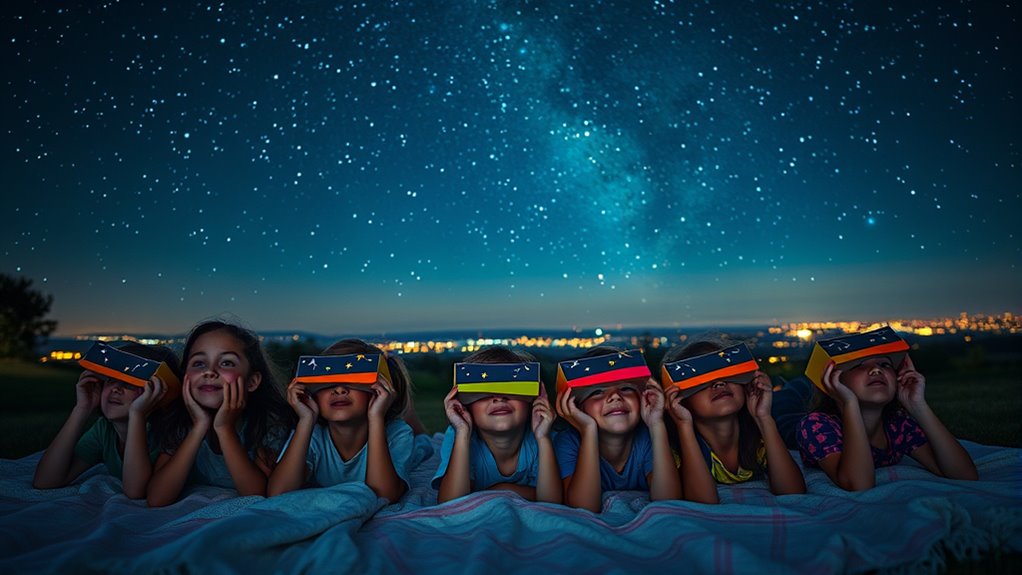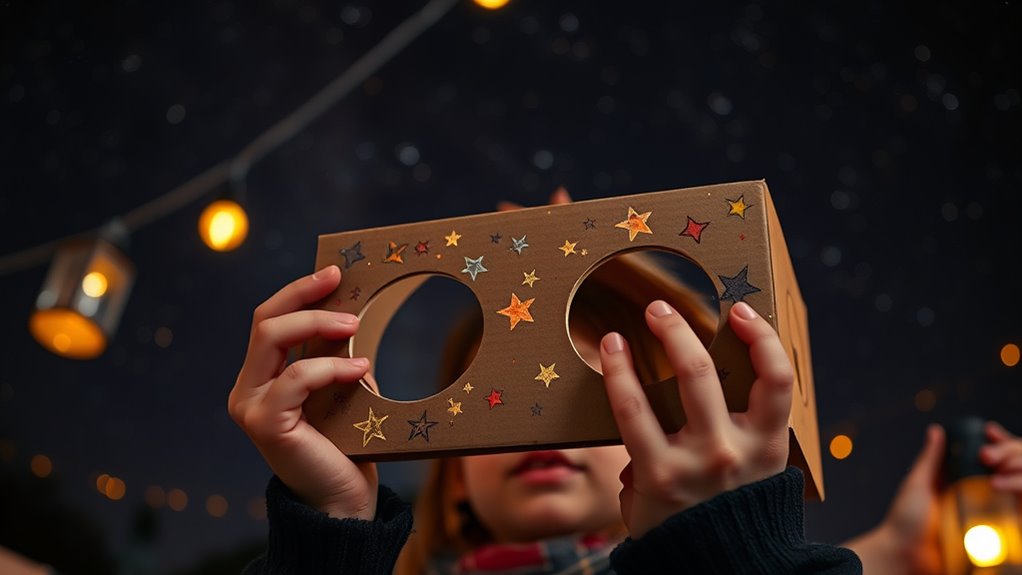Stargazing for kids offers a fun way to explore the universe and spark curiosity. You can create DIY constellation viewers using simple materials like cardboard, pins, and a flashlight, making stargazing accessible indoors or in your backyard. These projects teach patience and observation skills while helping children understand star patterns. Combining homemade tools with visits to planetariums creates a full, engaging experience. Keep exploring to discover even more ways to ignite your child’s passion for space!
Key Takeaways
- DIY constellation viewers are affordable, easy-to-make projects that enhance children’s understanding of star patterns and celestial navigation.
- Incorporating these viewers into educational activities promotes hands-on learning and stimulates curiosity about astronomy.
- Combining DIY projects with visits to planetariums offers a comprehensive, engaging stargazing experience for kids.
- Small businesses can sell kits and instructions for DIY constellation viewers, encouraging family participation in astronomy education.
- Creating a business around DIY constellation viewers fosters ongoing interest in space exploration while making astronomy accessible and fun.

Have you ever looked up at the night sky and wondered what those twinkling stars are? If so, you’re not alone. Stargazing is one of the most exciting ways to explore the universe, and introducing kids to it can turn a simple night outdoors into an unforgettable adventure. One great way to get started is by planning a trip to a planetarium. These visits let you and your child step inside a simulated night sky, where you can learn about constellations, planets, and celestial events in a fun, immersive environment. Planetarium visits are perfect for sparking curiosity and providing a solid foundation of astronomical knowledge. They often feature engaging shows and exhibits that make understanding the cosmos accessible for young minds. After experiencing a planetarium, your kid might feel inspired to explore the night sky on their own, which is where a DIY constellation viewer comes in handy.
Building your own constellation viewer is a simple and rewarding project that can bring stargazing closer to home. It involves basic supplies like a cardboard box, a pin, and a flashlight or small LED light. You cut holes in the shape of constellations or stars and then shine the light through them onto a wall or ceiling. This DIY device allows your child to learn the shapes of different constellations and understand how stars are grouped in the sky. Plus, it’s a portable and inexpensive way to explore night sky patterns from your backyard or even indoors during cloudy nights. As you assemble the constellation viewer, you’re also teaching your child about the importance of patience and precision—skills essential for real telescope assembly later on.
Speaking of telescopes, if your child becomes really interested, you might consider getting a beginner telescope. When assembling a telescope, you’ll want to involve your kid in every step—reading instructions, handling parts, and aligning lenses. This hands-on approach helps demystify the mechanics of astronomy and makes stargazing a shared learning experience. Once assembled, your telescope becomes a window to planets, moons, and distant galaxies. Learning how to use it properly, adjusting focus, and tracking celestial objects can be challenging at first, but it’s incredibly rewarding. It’s also a perfect way to turn a simple hobby into a family activity that encourages curiosity, patience, and a lifelong love of the stars. Pairing visits to the planetarium with DIY projects and telescope assembly creates a *thorough* , fun, and educational journey into the universe for your little explorer.
Frequently Asked Questions
What Are the Best Times of Year to Stargaze With Kids?
The best stargazing seasons for you and your kids are during clear, dark nights in late fall, winter, and early spring. These times offer the best stargazing seasons with minimal moonlight, giving you prime night sky viewing. Plan your outings when the sky is cloudless, and avoid full moons for the clearest view. Your kids will love discovering constellations during these ideal times of year.
How Can I Make Star Maps Suitable for Children?
To make star maps suitable for children, start with interactive star maps that engage their curiosity and make learning fun. Use colorful constellation charts to highlight different shapes and stories, making it easier for them to recognize patterns. Keep the maps simple and vibrant, and consider adding fun facts or stickers to encourage exploration. This approach helps kids connect with the night sky while fostering their interest in astronomy.
Are There Any Safety Precautions for Outdoor Nighttime Activities?
When planning outdoor nighttime activities with children, you should always prioritize safety. Make sure to supervise your kids closely to prevent accidents and keep them engaged. Check the weather forecast beforehand to verify conditions are suitable, and dress everyone appropriately. Keep flashlights handy, and stay on familiar, well-lit paths. Being prepared and vigilant helps prevent injuries and makes the experience enjoyable and safe for everyone involved.
What Are Some Beginner-Friendly Telescopes for Kids?
Did you know that over 60% of beginner telescopes are perfect for kids? For easy stargazing, choose a beginner-friendly telescope with good tripod stability to prevent shaky views. Look for models with built-in solar filters—these protect young eyes from the sun’s harmful rays. Such telescopes are simple to use, lightweight, and durable, making them ideal for kids just starting their astronomy adventures and ensuring safe, clear views of the night sky.
How Do I Teach Kids to Identify Different Constellations?
To teach kids to identify constellations, start with simple star gazing tips like finding a dark spot and using a star map. Share engaging constellation myths to spark their imagination, making learning fun. Encourage them to observe patterns and connect the dots. As they become familiar, introduce more complex constellations. Keep sessions short and interactive, and celebrate their discoveries to foster a love for night sky exploration.
Conclusion
So, despite all your DIY efforts, you might still find yourself staring at a sky full of questions rather than stars. Who knew that a simple constellation viewer could turn your backyard into a universe of wonder? Maybe the real magic isn’t just spotting stars, but discovering how easy it is to bring the cosmos a little closer—without needing a telescope or a Ph.D. After all, sometimes the best stargazing is just a homemade gadget away.











